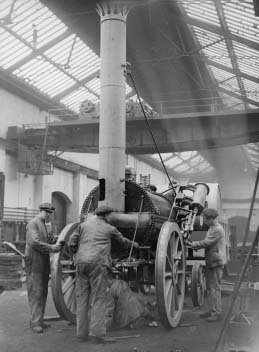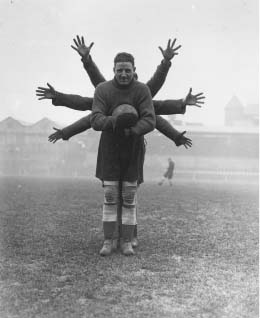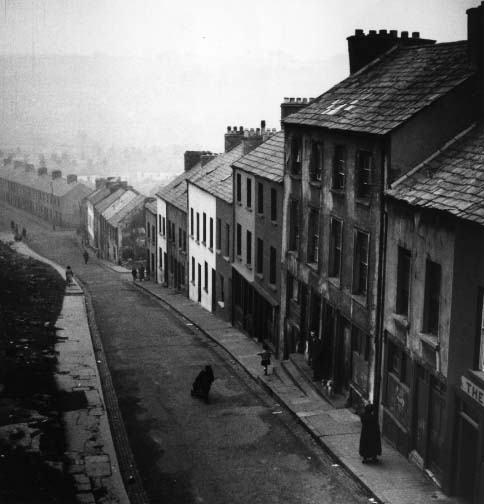Lyttelton's Britain (26 page)
Read Lyttelton's Britain Online
Authors: Iain Pattinson
The church of St Cuthbert was actually built in the 12th Century by Bishop Pudsey, who preached in his purple robe and wearing a spotted handkerchief knotted over one eye. His sermons often went on for over eight hours, without even the
occasional unfunny joke, and would only stop when people started throwing money.
In the early 19th Century, Darlington’s thriving cattle market was at the centre of an agricultural revolution. Two local farmers, Robert and Charles Colling, experimented with the breeding of shorthorn cattle, which resulted in the famous ‘Durham Ox’. One prime specimen, known as the ‘Comet’, which weighed in at 189 stones, won many prizes at the Durham Show in 1810. Her Royal Highness Princess Louise honoured the brothers, when she personally inspected and tied rosettes on their gigantic ox.
Darlington’s history since 1825 is of course synonymous with the railway, when the scheme to run a line from Darlington to Stockton was hatched by local businessman Edward Pease. He had settled in Darlington to found the local Quaker movement, a new religion which worshipped porridge oats. Pease commissioned the engineer George Stephenson, and soon the world’s first passenger railway was opened. Stephenson’s engine was a wonder of single-compression cylinder technology called the ‘Locomotion’, which, although requiring a whole new range of skills, was remarkably simple to operate, as illustrated by this extract taken from the original instruction handbook: ‘My little baby sister can do it with ease. It’s easier than learning your ABC’s. So come on, come on, do the Locomotion with me.’

Finishing touches to the world’s first Teasmaid
Tickets to ride on Stephenson’s new engine sold briskly, and within weeks 600 passengers were catching the train to Stockton every day until, after two months, the town was completely deserted.
The Darlington of today benefits from many facilities, including its own international airport at Teesside, on the old RAF base at nearby Middleton St George. It was from there that, in 1927, one Alf Gardiner departed on his attempt to fly solo all the way to Australia. His journey went well until engine trouble forced him to ditch in Borneo, where he landed on a rubber plantation, and bounced all the way back to Singapore.
As the area of the Tees Valley around the town is well known for the proliferation of cuckoos, Darlington is home to the British Cuckoo Society, whose office is to be found on Church Street. It’s actually a branch of the Halifax, but whenever they go out to lunch, they come back to find the Cuckoo Society has moved in.

T
HE CITY OF
Sunderland is located in the fine county of Tyne and Wear. A settlement first appeared in the 7th Century, when Vikings stopped off on their way to Greenland. The town was therefore called ‘Soenderlundt’, being an old Norse word meaning ‘Who was reading the bloody map?’
The Saxon King Egfrith set up court in Sunderland to rule Northumbria and fight the Vikings, who had captured Newcastle. However, after negotiations, Egfrith took the town back for a payment of twelve silver shillings. Not a great sum even then, but the Vikings couldn’t afford to pay more.
Probably the most important aspect of Sunderland’s early growth was shipbuilding, which began there in 1346 at the beginning of the Hundred Years War. Many vessels were built to carry troops, but recruitment was difficult, as so few soldiers were prepared to sign up for that long. Because of their long association with the making of ships, the people of Sunderland became known as ‘Makems’, or, more correctly now, ‘Used-to-Makems’.
The family of the first US President, George Washington, came from this area. It was George Washington who led the revolt by the American colonists, as they no longer wished to be treated as the subservient lackeys of Britain. Well he certainly reversed that one. And so the War of Independence began, and soon Americans
were raining canon salvos down upon their former British allies. A tradition they proudly preserve to this day.
The author Lewis Carroll was a regular Sunderland visitor and set sail from there on his journey to China. Carroll’s inspiration for the name ‘Wonderland’ came when he heard the word ‘Sunderland’, and simply substituted the first letter. Luckily, he wasn’t going to Nanking.
It was Sunderland’s Chief Constable, Frederick Crawley, who designed the first police box. His concept was taken as the model for the Tardis, which appears large on the inside despite being quite tiny on the outside. When Mr Crawley left the Force, he took up photography, producing sales brochures for Barratt Homes.
Sunderland is rightly proud of its fine football team. In 1989, Sunderland AFC were required to turn their old Roker Park home into an all-seater stadium, but the scheme failed when the team found it nearly impossible to play the long ball game sitting down. Instead, a site for a new stadium was found at nearby Monkwearmouth. Work on the replacement ground began in 1996, when it was labelled ‘the Wembley of the North’. However, as the city wanted it completed before the entire team died of natural causes, it was renamed ‘The Stadium of Light’. That name was borrowed from Benfica’s stadium in Lisbon, because of the obvious similarity between the two cities: Lisbon is a coastal city of constant sunshine, boasting Baroque and Romanesque architecture, whose cultural heritage makes it a Mecca for writers and artists, and Sunderland is also on the coast.

On its first day of opening, the new Dr Who Museum was visited by over 120,000 (all inside)

The Windscale works football team’s most successful goalkeeper
The intrepid BBC reporter, Kate Adie, was brought up in Sunderland. Miss Adie was present at the storming of the Iranian Embassy, the invasion of Iraq, the bombing of Tripoli and three Turkish earthquakes. When she returned to Sunderland to launch a ship, the crew shot an albatross for luck.
Sunderland has recently become famous for its call centres, and is rightly known as the UK’s Call Centre Centre. The city was chosen because the North East accent is rated the most trustworthy in the country. And who wouldn’t believe someone who told you your call was important to them, every 10 seconds for three quarters of an hour?

N
EWCASTLE
is a fine historic city with much to interest the foreign visitor. A fortified settlement was established there in Roman times by Hadrian, the regional consul who became famous for the building of Roman Walls; in fact, by the end of his lifetime they became one of the largest ice-cream suppliers of the 3rd Century.
In the Saxon period the town was known as ‘Monk Chester’, because of the large number of monks there, but was subsequently occupied by marauding Vikings, when it became known as ‘Danish Gitchester’.
But the city took its modern name when the old city ramparts were replaced by a ‘new castle’, built by Robert Curthose, the bastard son of William the Conqueror. He wasn’t in fact illegitimate; that’s just what customers called him when they saw his shoddy building work.

The world’s first solar-powered light bulb. (Not glowing due to lack of sunlight)
Newcastle also proudly boasts the birthplace of the electric light bulb, the gas turbine and the
steam locomotive, and it was in Newcastle that the Industrial Revolution reached its peak with the first successful demonstration of Stephenson’s Rocket, following the earlier disappointment when Stephenson’s Milk Bottle fell over.
As the main seaport linking England with Scandinavia, Captain Scott sailed from Newcastle to train for his polar expedition. Returning some months later in anticipation of a warm and passionate greeting from his young fiancée, one can only imagine his dismay on finding a Norwegian had got there first.
